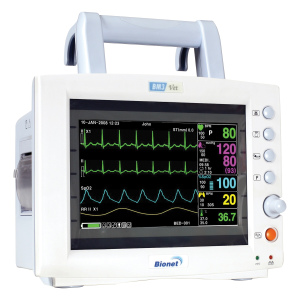Six Essential Anesthetic Monitoring Devices for Pets

Your pet is having surgery today and you can’t help but worry. Rest assured that your vet’s health care team will be working diligently to make sure that everything goes smoothly. There are a variety of monitoring devices that may be utilized during the surgery to ensure that your pet does well under anesthesia. Early detection of any small deviations in your pet’s status will allow the anesthetist to take appropriate action to restore balance. Here is a list of the top six essential pieces of anesthetic monitoring equipment that should be present in every operating room:

1. Non-Invasive Blood Pressure (NIBP). An inflatable cuff is applied to one of your pet’s legs. The cuff is temporarily filled with air until the blood flow is occluded. Your pet’s blood pressure can be determined by the pressure in the cuff required to stop the flow of blood in the arteries. Adequate blood pressure is necessary to maintain blood flow to all the vital organs.
2. Pulse Oximetry (often abbreviated as pulse-ox). This is a non-invasive method of measuring arterial blood oxygen saturation. A sensor is attached to your pet (typically the tongue, ear, lips or toe web) and a light is transmitted through the body part to a photodetector. The amount of light absorbed is used to calculate oxygen saturation levels in the hemoglobin to make sure that adequate oxygen is being delivered throughout the body.
3. Capnography. A sensor is attached to the anesthesia machine and is used to measure the amount of carbon dioxide in the exhaled breaths. The carbon dioxide level at the end of each breath is a very sensitive indicator of a properly functioning respiratory system.
4. ECG. Electrodes are used to measure the electrical activity of your pet’s heart during surgery. Normal heart function requires a beautifully coordinated sequence of electrical impulses passing through the heart muscle to trigger the heart to beat. Any alterations in these electrical impulses can affect the efficiency of the heart pump.
5. Temperature. It is common for body temperature to drop during surgery. This has been shown to cause increased bleeding, cardiovascular problems, and prolonged recovery from anesthesia. Your pet will be kept warm during surgery by using heating pads (electric heating pads have been replaced by circulating warm air or water blankets) or hot water bottles. In addition, IV fluids may be warmed to minimize any heat loss during surgery.
6. Trained Anesthetist. No expensive piece of equipment, no colorful display, no alarm bell can replace an alert, trained anesthetist. The job of the anesthetist is to monitor your pet from the beginning of anesthesia through recovery. They will be focusing on breathing patterns, muscle tone, pulses, color, etc. to ensure a safe anesthetic procedure.
Your veterinarian and the hospital staff are focused on one thing only: diagnosing and treating your pet’s health concerns so that they can return home happy and healthy!
Leave a reply →